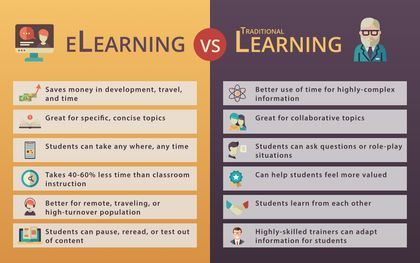Instructor-Led Training vs. eLearning
Corey Bleich
🍿 4 min. read
Instructor-led training (ILT) is the more traditional, formal version of training that takes place in a classroom in front of learners, while eLearning is web-based and can be taken at anytime from an internet-connected device. And, then there's blended learning. If you're trying to find the best training program for your employees, there are a few things to consider when it comes to ILT vs. eLearning, or even blended training. This is what you should know.
What is ILT?
ILT, or instructor-led training, is the type of training you're most familiar with. It's training that occurs in a classroom. There's a teacher presenting the material. And, for many employees for many subjects, this can be the most effective method of training.
All of this, however, depends on what your specific needs are. Some topics will greatly benefit from instructor-led training. Some, however, will be better matched to eLearning as we'll discuss shortly.
Advantages of ILT
One of the greatest advantages of instructor-led training is that employees have the opportunity to ask questions. Highly-trained corporate trainers and instructors can also adapt their presentations to the skill level and personality of the class they're teaching.
Instructor-led, or traditional, classes can also break off into brainstorming or role-playing groups. Employees get a chance to learn from each other. Most importantly, for complex or highly collaborative subjects, instructor-led training provides the direct immersion experience employees need to learn the material.
Other indirect benefits stem from this. Since employees are in a classroom setting, their attention is more likely engaged with the material. And, as PhoenixTS reports, there's an added value and sense of worth for in-person training, especially among healthcare and customer service employees.
Challenges of ILT
Challenges do exist with instructor-led training. eLearning offers solutions to many of these challenges, including:
- High cost of implementation, both in terms of time and money
- Inconsistent messaging and teaching styles of instructors
- Time away from work
- Interruption to employee's daily tasks
What is eLearning?
eLearning, on the other hand, offers both opportunities and different challenges for your training program. eLearning refers to any training that takes place online, any where and any time.
Since it's delivered online, eLearning solutions can include videos, tests, activities, and images in the training. Upcoming eLearning technologies promise even more immersion for your employees, including:
- Augmented reality
- Virtual reality simulations
- Interactive videos
- Mobile learning
- Gamification
- Geofenced training areas
- Personalized learning paths
Advantages of eLearning
eLearning provides distinct advantages for companies. There's a reason that more than 40% of Fortune 500 companies use eLearning, and 72% of organizations claim that eLearning provides them with a distinct competitive advantage as reported by eLearningIndustry.com.
The advantages of eLearning include:
- Saving companies money, in terms of development hours, travel costs, and employee time away from work
- Taking less time away from an employee's work day, as eLearning takes up to 40-60% less time than classroom instruction
- Allowing employees more flexibility to access training when and where they have the time to do so
- Being particularly suited for employees who are remote, traveling, or have high turnover rates
- Creating personalized custom eLearning solutions that can be tailored to better match the specific learner
- Allowing employees to pause training, reread information, or test out of information they already know
- Increasing employee retention of information, for specific subjects
These advantages are best accessed when the eLearning course is:
- Focused on a single, accessible topic, such as sexual harassment or a software demo
- Concise, to-the-point, and organized in small chunks to discourage scanning or skimming
- Enhanced, but not distracted, by visuals, animations, and activities
Challenges of eLearning
It's specifically because of all those bells and whistles that eLearning can lose students in many ways. eLearning solutions that rely on overly flashy graphics or animations are distracting to students. eLearning can also become outdated, especially for rapidly evolving fields, unless active revisions are part of the training design process.
Just like instructor-led training, eLearning courses must focus on the core principles of instructional design to accurately and concisely communicate information to your employees. No number of mobile apps, interactive videos, or VR experiences is going to change that.
eLearning vs. traditional learning infographic

The best of both worlds: Blended learning
There is one more option. Blended learning incorporates ILT and eLearning, and it’s often utilized to boost the benefits of both. A U.S. Department of Education survey of over 1,000 independent studies showed that instruction that combined online and face-to-face elements had a larger advantage than eLearning or instructor-led training alone.
How does blended learning work?
Take for example, Jiffy Lube, who structured their Leadership Training program into two sections: instructor-led classes that focused on the collaborative elements of leadership, and eLearning courses for straightforward topics like financials and time management.
After providing this blending learning experience, Jiffy Lube saved over eight hours per employee.
What will work best for our company?
Quite simply, it depends. Your topic, employee population, and training resources will all dictate whether ILT vs. eLearning will be more successful for you.
ILT can incorporate many different styles of learning easily, and in-person training tends to be more personal and helps to build relationships. eLearning is more flexible, though, and learners can refer back to courses over and over. Blended learning incorporates benefits of both options to save time and money, while increasing overall employee engagement.
One of our eLearning consultants at EdgePoint Learning can help you break down your specific needs and suggest options that would work best for you. Contact our team to determine which style of instruction is best for you and your organization.
